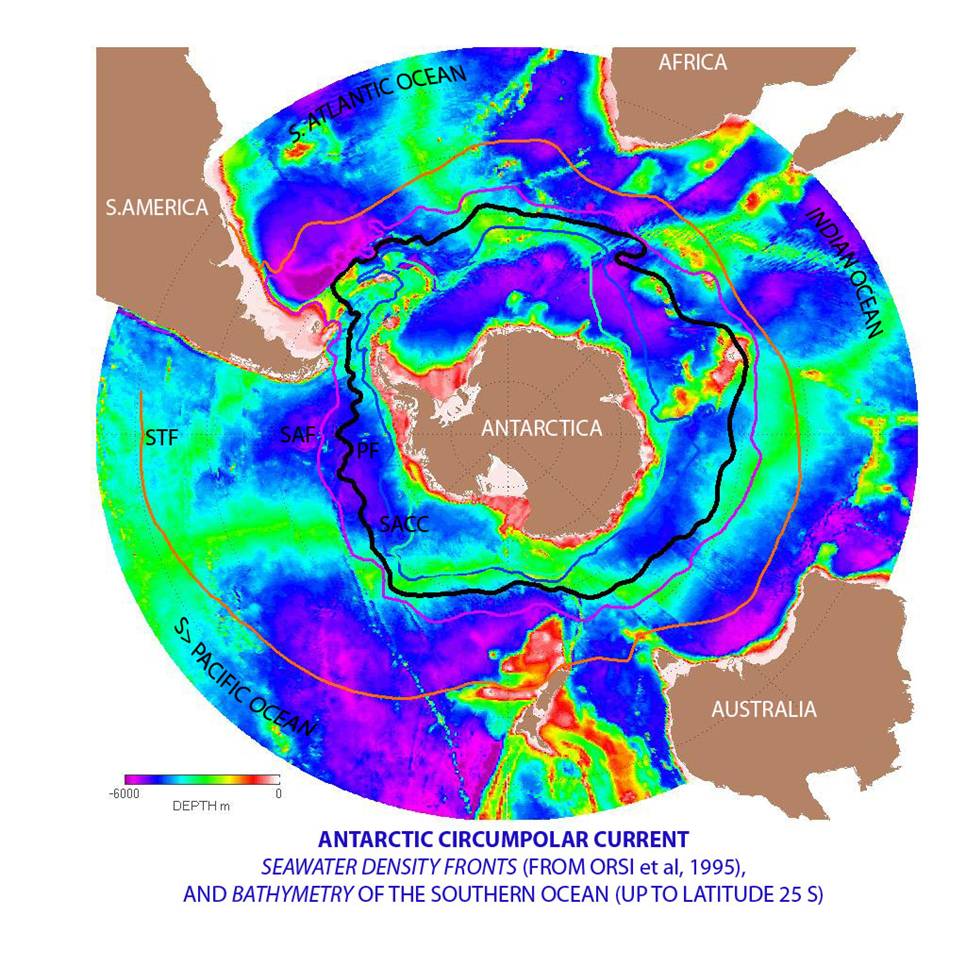Antarctic Circumpolar Current
The Antarctic Circumpolar Current (ACC) is an ocean current that flows clockwise from west to east around Antarctica. An alternative name for the ACC is the West Wind Drift. The ACC is the dominant circulation feature of the Southern Ocean and has a mean transport estimated at 100-150 Sverdrups (Sv, million m³/s), or possibly even higher, making it the largest ocean current. The current is circumpolar due to the lack of any landmass connecting with Antarctica and this keeps warm ocean waters away from Antarctica, enabling that continent to maintain its huge ice sheet.
Associated with the Circumpolar Current is the Antarctic Convergence, where the cold Antarctic waters meet the warmer waters of the subantarctic, creating a zone of upwelling nutrients. These nurture high levels of phytoplankton with associated copepods and krill, and resultant foodchains supporting fish, whales, seals, penguins, albatrosses, and a wealth of other species.
The ACC has been known to sailors for centuries; it greatly speeds up any travel from west to east, but makes sailing extremely difficult from east to west; although this is mostly due to the prevailing westerly winds. The circumstances preceding the mutiny on the Bounty and Jack London's story "Make Westing" poignantly illustrated the difficulty it caused for mariners seeking to round Cape Horn on the clipper ship route between New York and California. The clipper route, which is the fastest sailing route around the world, follows the ACC around three continental capes – Cape Agulhas (Africa), South East Cape (Australia), and Cape Horn (South America).
Dynamics
The circumpolar current is driven by the strong westerly winds in the latitudes of the Southern Ocean.
In latitudes where there are continents, winds blowing on light surface water can simply pile up light water against these continents. But in the Southern Ocean, the momentum imparted to the surface waters cannot be offset in this way. There are different theories on how the Circumpolar Current balances the momentum imparted by the winds. The increasing eastward momentum imparted by the winds causes water parcels to drift outward from the axis of the Earth's rotation (in other words, northward) as a result of the Coriolis force. This northward Ekman transport is balanced by a southward, pressure-driven flow below the depths of the major ridge systems. Some theories connect these flows directly, implying that there is significant upwelling of dense deep waters within the Southern Ocean, transformation of these waters into light surface waters, and a transformation of waters in the opposite direction to the north. Such theories link the magnitude of the Circumpolar Current with the global thermohaline circulation, particularly the properties of the North Atlantic.
Alternatively, ocean eddies, the oceanic equivalent of atmospheric storms, or the large-scale meanders of the Circumpolar Current may directly transport momentum downward in the water column. This is because such flows can produce a net southward flow in the troughs and a net northward flow over the ridges without requiring any transformation of density. In practice both the thermohaline and the eddy/meander mechanisms are likely to be important.
The current flows at a rate of about 4 km/h (2.5 mph) over the Macquarie Ridge south of New Zealand. The ACC varies with time. Evidence of this is the Antarctic Circumpolar Wave, a periodic oscillation that affects the climate of much of the southern hemisphere. There is also the Antarctic oscillation, which involves changes in the location and strength of Antarctic winds. Trends in the Antarctic Oscillation have been hypothesized to account for an increase in the transport of the Circumpolar Current over the past two decades.
